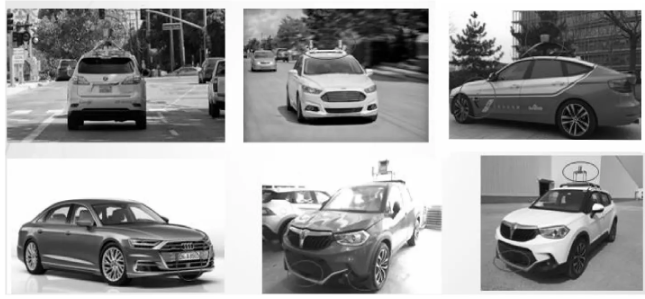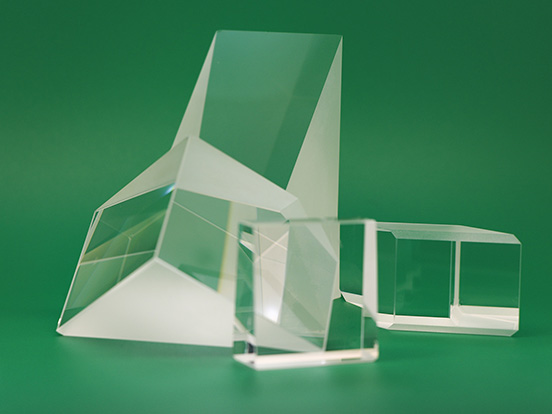Applications in laser radar
Sep. 25, 2023
Definition of LiDAR
LIDAR is a radar working in the light wave frequency band, which uses electromagnetic waves in the light wave frequency band to first transmit detection signals to the target, and then compares its received signals with the transmitted signals, so as to obtain information on the target's position (distance, bearing and altitude), motion status (speed and attitude), etc., and to realize the detection, tracking and identification of the target.
Lidar is divided into two main categories depending on the installation location. One category is installed around the smart networked vehicle or driverless car, and the other category is installed on the roof of the smart networked vehicle or driverless car, as shown in the figure.Lidar installed around the intelligent networked vehicle or driverless car, its laser beam is generally less than 8, and there are common single-beam Lidar and four-beam Lidar, which are applicable to the L3 level or below; Lidar installed on the roof of the intelligent networked vehicle or driverless car, the chiaroscopic light beam is generally not less than 16, and there are common 16/32/64-beam Lidar, which are applicable to the L3 level or above. Less beam LiDAR is mainly used for advanced driver assistance system that can only look forward to the coming year car, and multi-beam LiDAR is mainly used for making high-precision maps of driverless cars and for road and vehicle identification, etc.

Features of laser radar
Wide detection range. Detection distance can reach more than 300m
High resolution. LIDAR allows for very high distance, speed and angular resolution. Usually, the distance resolution of LIDAR can reach 0.1m; the speed resolution can reach 10m/s or less; and the angular resolution is not less than 0.1mard, that is to say, it can resolve two targets that are 0.3m apart within a distance of 3km, and can track multiple targets at the same time.
Informative. It can directly obtain the distance, angle, reflection intensity, speed and other information of the detected target, and generate a multi-dimensional image of the target.
Can work around the clock. Laser active detection, does not depend on the external lighting conditions or the radiation characteristics of the target itself, it only needs to emit its own laser beam, through the detection of the return signal of the emitted laser beam to obtain target information.
Components of LIDAR
The LIDAR system for smart internet-connected vehicles consists of a transceiver antenna, a transceiver front-end, a signal processing module, a vehicle control device and an alarm module.
Transceiver antenna. For beam less LIDAR, the transceiver antenna may be mounted in the vehicle bumper to transmit signals to the front of the vehicle and receive reflected signals.
Send/receive front end. The transceiver front-end is the core component of the radar system, responsible for signal modulation, RF signal transmission and reception, and received signal conditioning.
Signal Processing Module. The signal processing module automatically analyzes and calculates the distance and relative speed to the vehicle in front, and prevents incorrect measurement of vehicles in the adjacent lane when turning.
Automotive Controls. Automotive controls are automatic operating systems that control the automobile's ability to automatically slow down or emergency brake. By limiting engine output torque, regulating braking force and transmission gears, it controls the traveling speed of the automobile.
Alarm Module. According to the set safety distance and alarm distance, give the driver an alarm in an appropriate way to ensure the safe driving of the car.
LIDAR Ranging Principle
The ranging principle of LiDAR is to calculate the distance to the target by measuring the round trip time between the laser emission signal and the laser return signal. First of all, the laser radar sends out a laser beam, the laser beam is reflected back after touching the obstacle, and is received and processed by the laser receiving system, so as to know the time between the laser from launching to being reflected back and received, i.e., the flight time of the laser, and according to the flight time, the distance of the obstacle can be quadratically looped out.
According to the different forms of the emitted laser signals, laser ranging methods include pulse ranging, interferometric ranging and phase ranging.
Types of LiDAR
LIDAR can be categorized into mechanical LIDAR, solid-state LIDAR and hybrid solid-state LIDAR according to the presence or absence of mechanical rotating parts.
(1)Mechanical LIDARs with rotating parts that control the angle of laser emission are large, expensive, have relatively high measurement accuracy, and are typically placed on top of the vehicle.
(2)Solid-state LiDAR relies on electronics to control the angle of emission and does not require mechanical rotating parts, so it is small enough to be mounted in the body of a vehicle.
(3)Hybrid solid-state LiDAR does not have a large-volume rotating structure, uses a fixed laser light source, changes the direction of the laser beam by rotating the internal glass sheet, realizes the need for multi-angle detection, and uses embedded mounting.
Key indicators of LiDAR
The main indexes of LIDAR are distance resolution, maximum detection distance, ranging accuracy, measurement frame rate, data sampling rate, angular resolution, field of view, wavelength and so on.
LIDAR Applications
(1)Pedestrian protection
Occasions when pedestrians appear on the roadway in front of the vehicle traveling and need protection from the vehicle. By analyzing the object's shape, speed, and leg movement to differentiate between pedestrians and ordinary objects, the sensor issues a warning 300ms before activating safety measures (such as airbags), which can protect pedestrians before a collision occurs.
(2)lane departure warning
Line less beam LiDAR detects lane line markings and potential obstacles ahead of the vehicle's travel, as well as extremely short vehicle positions in the roadway. The system gives an immediate warning if the vehicle is likely to veer off course.
(3)Traffic congestion assistance
The driver only needs to grasp the steering wheel of the car, and this function is especially important at road speeds of less than 30km/h. The gentle acceleration and deceleration and the reliable pedestrian protection function make driving the vehicle both safe and hassle-free.
(4)Automatic Emergency Braking
Beam less LIDAR monitors all stationary and moving objects in front of the vehicle in real time and determines their shape, automatically emergency braking when there is going to be danger.
LIDAR is a radar system that detects the position of a target by emitting a laser beam that operates in the infrared and visible wavelengths. Depending on the scanning mechanism, LIDAR is available in two or three dimensions. Most of them rely on a rotating mirror to emit the laser light and measure the distance by measuring the time difference between the emitted light and the reflected light on the surface of the object, while the mirror of three-dimensional LIDAR is also attached to a certain range of tilt in order to achieve the effect of surface scanning.
CLZ Optical Co., Ltd. has been manufacturing and trading optical components such as optical domes, optical windows, optical prisms, spherical and cylindrical lenses etc.Including the optical elements used in the LIDAR mentioned in this article mirrors, prisms, optical filters. We also could provide service of OEM, customized product for our customer. We use various materials such as optical glass N-BK7, HK9L, fused silica, sapphire, etc. as well as fluoride. Please contact us free time if you have any needs!



















